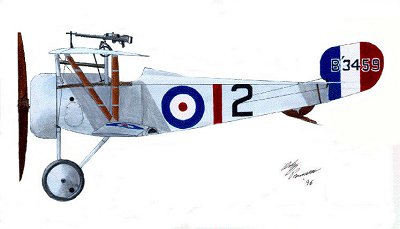Societe Anonyme des Etablissements Nieuport 17:
Historical Notes:
Like the 11, the 17 had a single spar lower wing, or sesquiplane, layout. Although providing the pilot with better vision, the design retained the weak lower wing of the 11, compelling pilots to take care when diving the machine since the spar could easily fracture. The upper wing was conventional for the time, with two spars forming a single bay. The fuselage was strengthened with steel tubing and ash to the front, and spruce to the back, while the entire structure was wire- braced.
The major improvement was in the armament, with a synchronized Vickers machine gun installed on centrally on the cowling to fire through the propellor arc. The cowling housed the canvas ammunition belts held in drums. Provisions were also made to carry eight Le Prieur anti-balloon rockets on the interplane struts. Some Nieuport 17s had single or twin Lewis guns mounted on the top wing, and some had a single Lewis on the wing to compliment the Vickers. The typical ammunition load was around 500 rounds.
Like many other aircraft of the time, the Nieuport 17 was powered by a rotary engine, typically the 110hp Le Rhone 9Ja. However, other variants were fielded, some with 130hp Clergets. This latter aircraft was known as the 17bis, and only a few were fielded. Heavier than earlier models, it was unpopular with pilots since it was sluggish and difficult to fly.
Although the Nieuport 17 had a better snap turn and equal stead turn to the Albatros D-III series, French pilots believed they were outclassed by the German machines, and demanded Spad VIIs, even though the latter's snap turn was worse than the 17. This can only be explained by the fact that aircraft tactics were moving away from the highly maneuverable and unstable aircraft to planes with more power and rugged construction. The Nieuport 17 could not stand up well to the rigors of combat, and for this reason many pilots wanted a machine with a stronger airframe. Interestingly, Albert Ball preferred the Nieuport 17 initially, until the strength of the new SE5 saved his life. After that, he flew the 17 only once more into combat, shooting down an Albatros D-III just prior to his death.
Basic performance statistics: Nieuport 17
Engine: 110hp Le Rhone Rotary
Weight: empty 825 lbs; loaded: 1,233 lbs
Maximum speed: 101 mph at 10,000 feet
Climb rate: to 10,000 feet.... 9 min.
Service ceiling: 17,400 feet
Flight endurance: 2 hours
Basic Specifications (varied with model):
Manufacturer: Societe Anonyme des Etablissements
Dimensions: Span 26 ft 10 in; Length 18 ft, 11 in; Height: 8 ft
Areas: Wings 158.77 sq ft
Fuel: na from sources
Armament: single Vickers machinegun mounted on cowling; 500 rounds typical load.
Primary sources: "French Aircraft of the First World War," Davilla and Soltan; "Jane's Fighting Aircraft of World War I, 1919 (1990 reprint); "British Aeroplanes, 1914-1918," J.M. Bruce; "German Aircraft of the First World War," Gray and Thetford; "German Air Power in World War I," Morrow; "Fighter Aircraft of the 1914-1918 War," Lamberton et al; "Aircraft vs Aircraft," Franks; "Who Downed the Aces in WWI?" Franks; "Aircraft Camouflage and Markings 1907- 1954," Robertson et al; "Military Small Arms of the 20th Century," Hogg and Weeks.
Fighting and winning in the Nieuport 17:
The Nieuport 17 does offer the dynamics to perform little tricks which can give you the edge in a close quarters aerial contest. The plane can float quite easily, due to its good horsepower to weight ratio. However, the stead turn is not great, and you will often roll over into a snap turn when maneuvering. Unlike the real thing, you can still dive and zoom this machine, since the flight dynamics currently does not allow for wing stress fractures and such when a plane is overtaxed. This can be effective, in that a Nieuport pilot can get above his foe, and then make small diving attacks, swooping down on one plane, only to pull up, and then swooping down on another. By maintaining an altitude advantage, one Nieuport can successfully engage two, three, or even four Albatroses, with reasonable possibilities of success.
